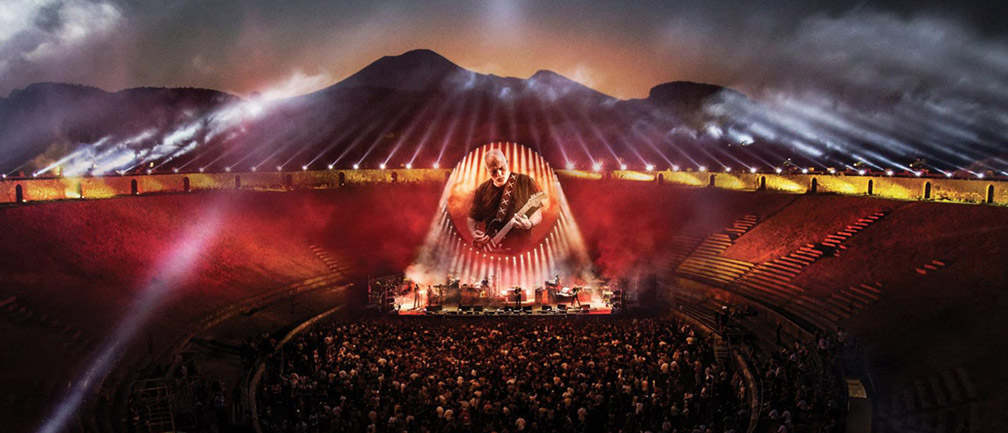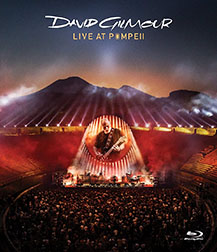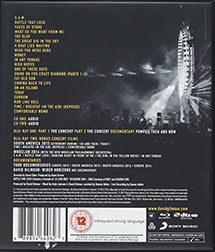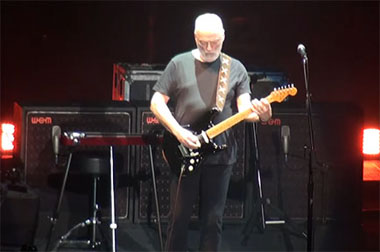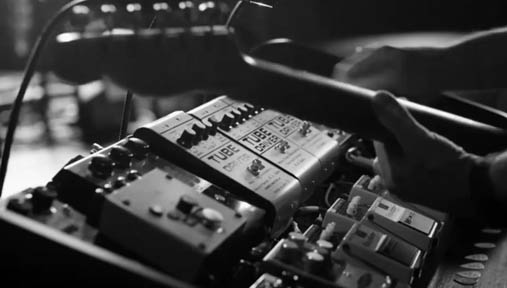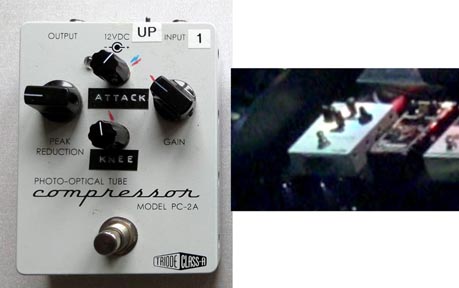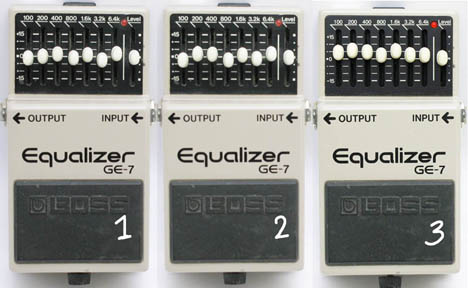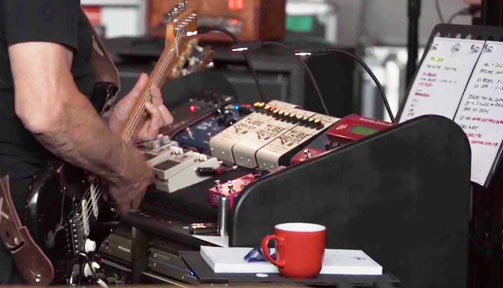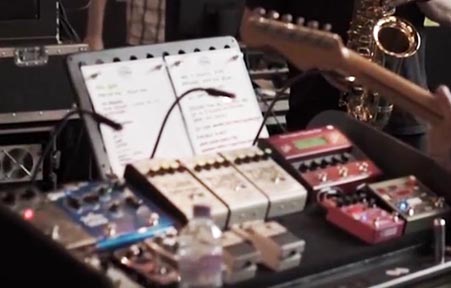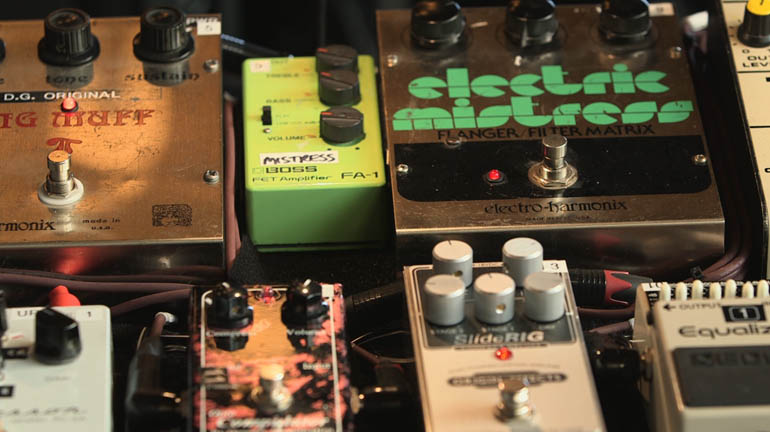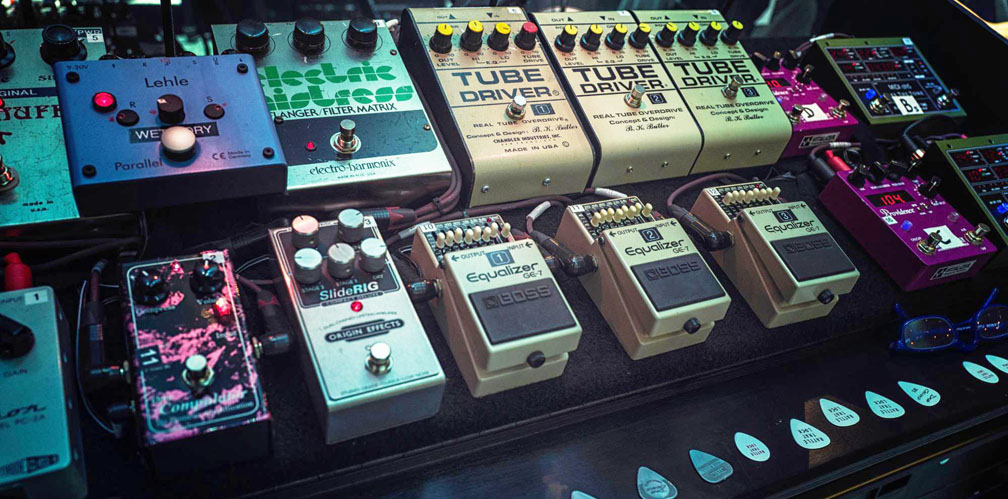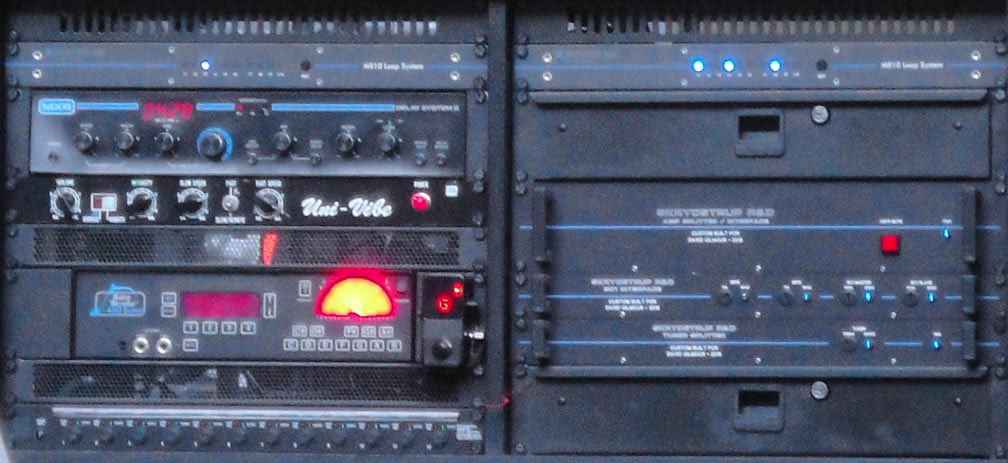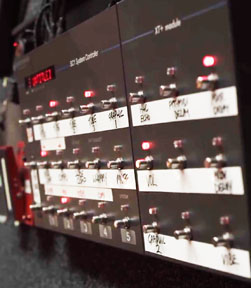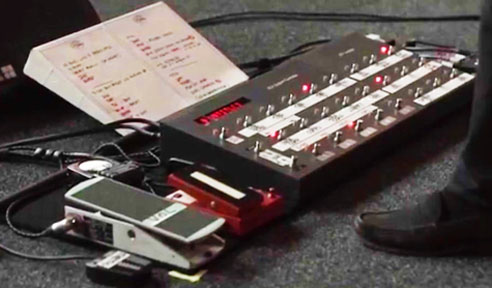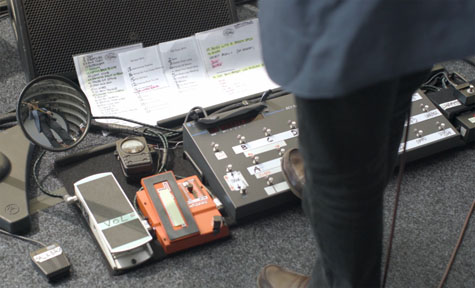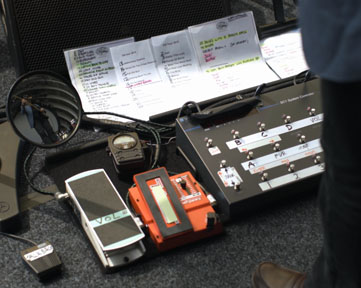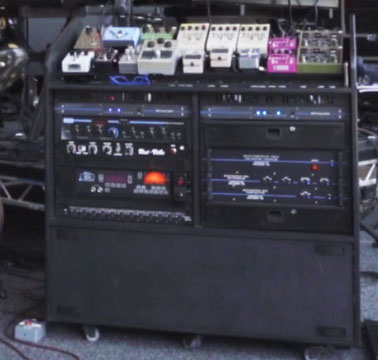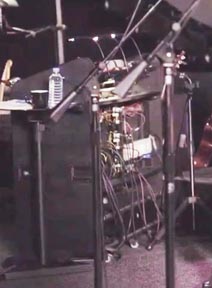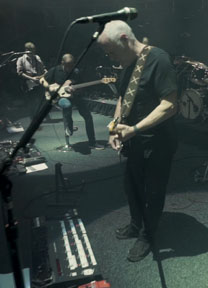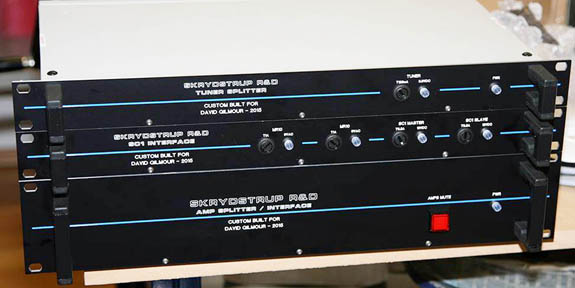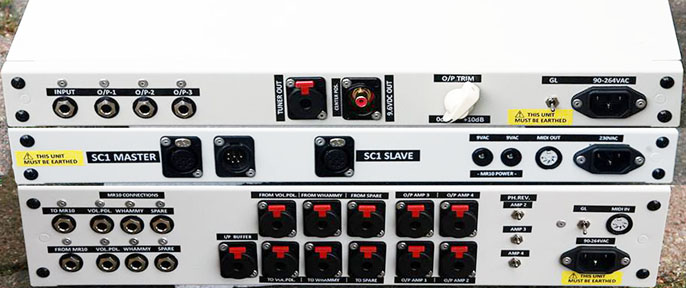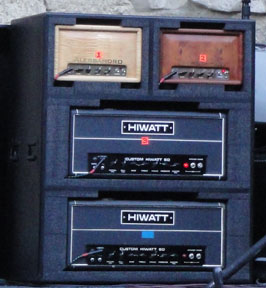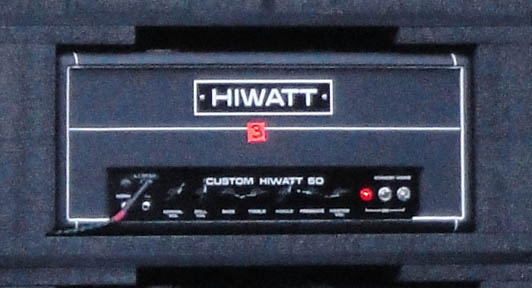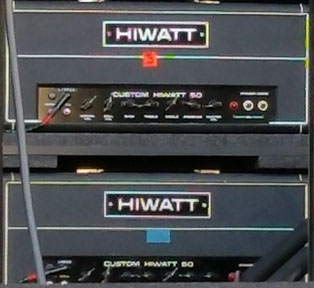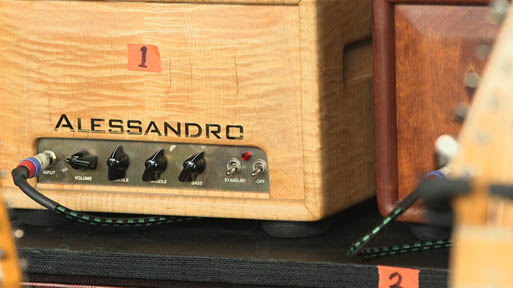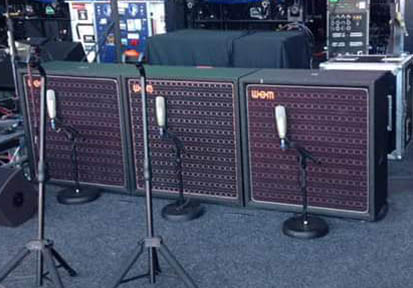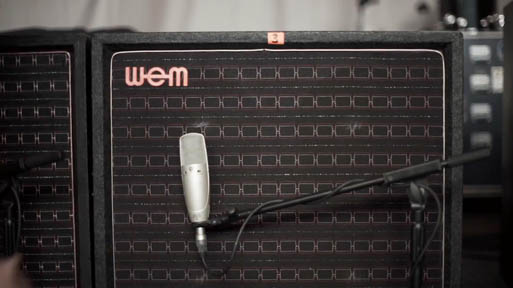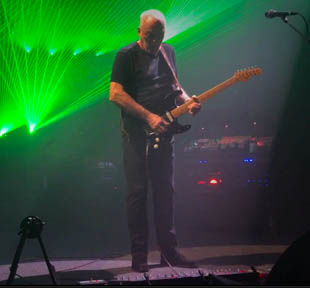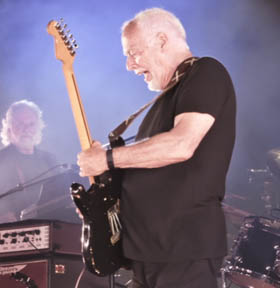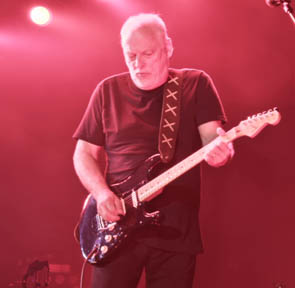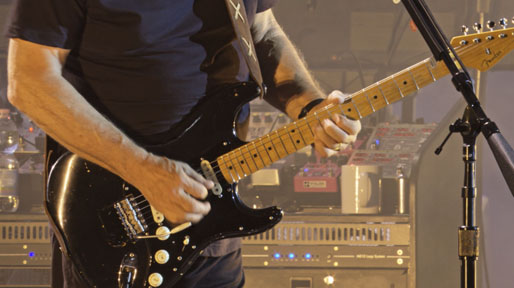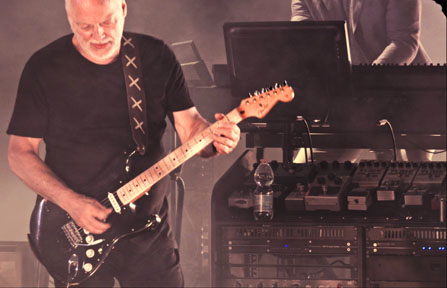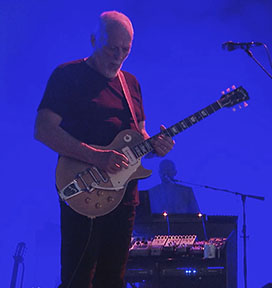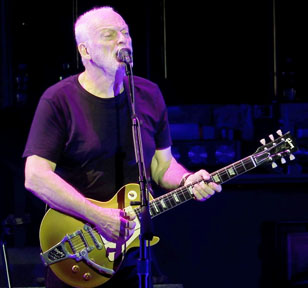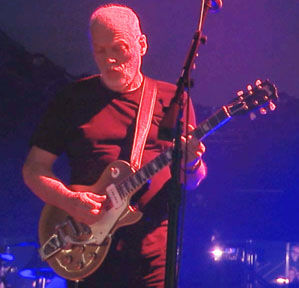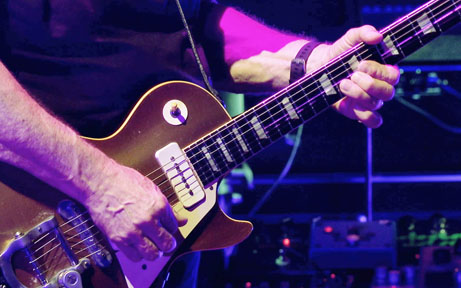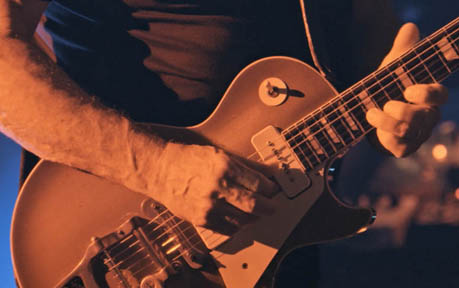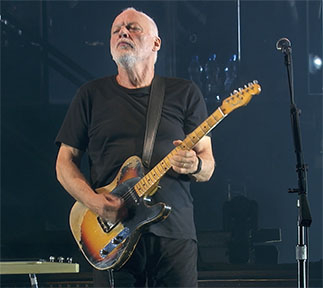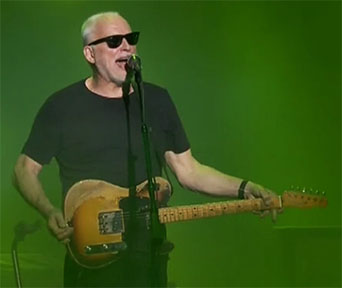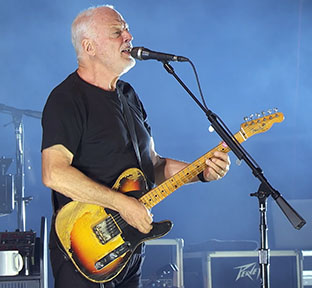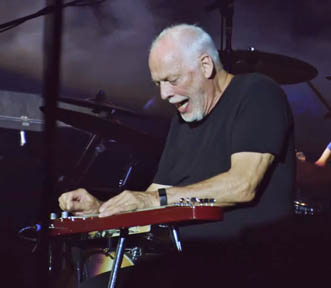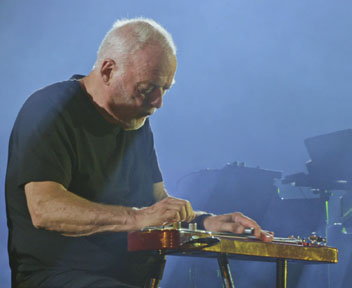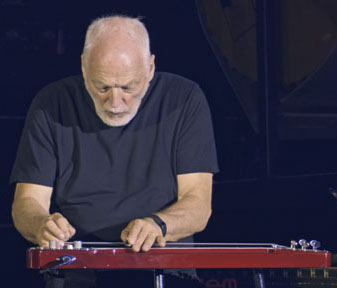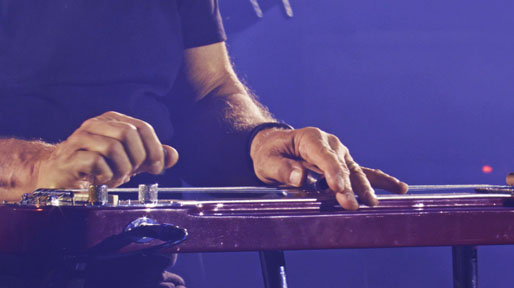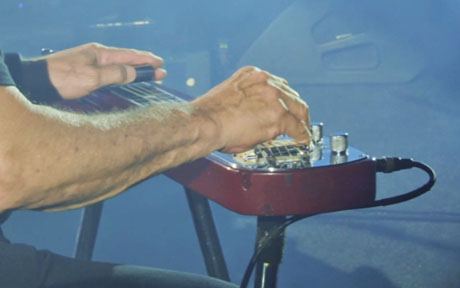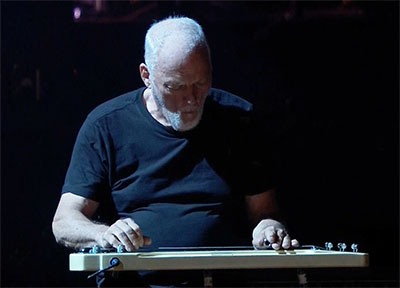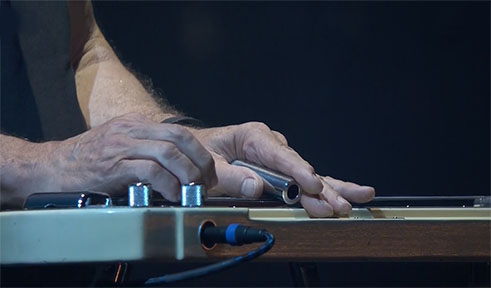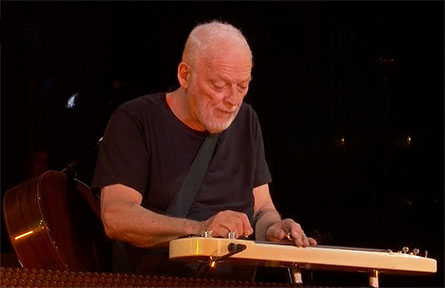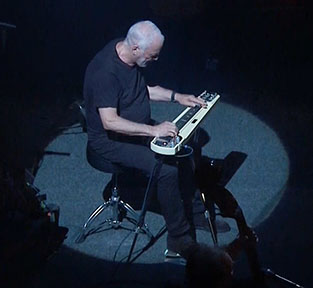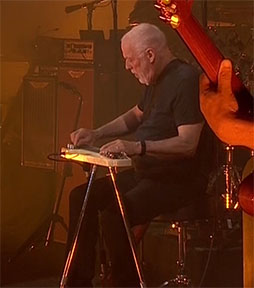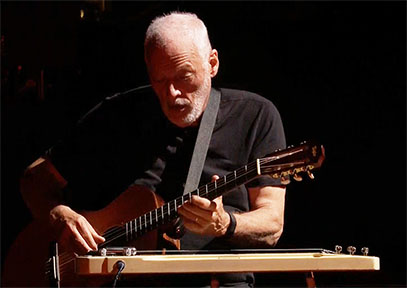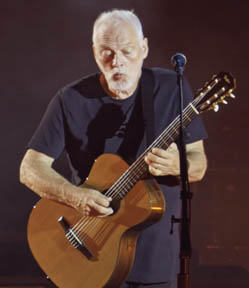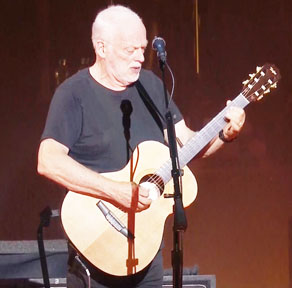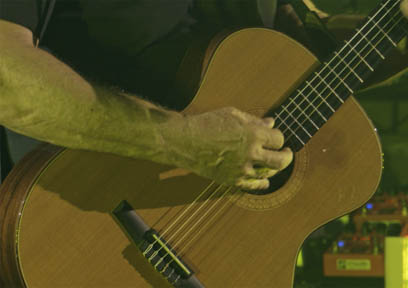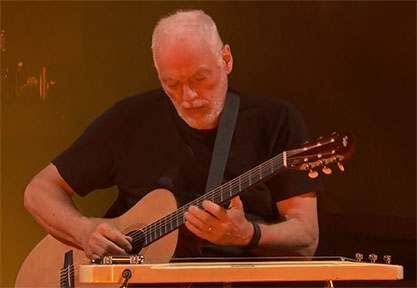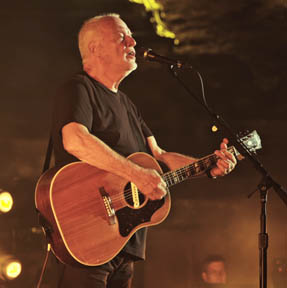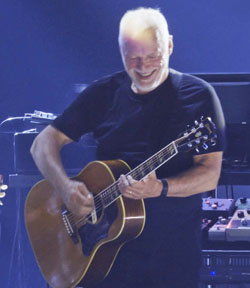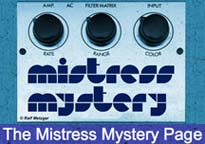NOTE: This website is frequently updated. Last update August 2023
For my setups and sound clips CLICK HERE
For song-by-song signal chains CLICK HERE
THE 2015-16 RATTLE THAT LOCK TOUR AND LIVE AT POMPEII - In 2015 David toured in support of his Rattle That Lock album. On June 25th, 2016 a concert was televised and streamed live from Freedom Square in Wroclaw, Poland. It featured a full orchestra conducted by Zbigniew Preisner, and David and his band were in top form. One of the other highlights of the tour was David performing in the same ancient Roman ampitheatre in Pompeii that Pink Floyd performed in back in 1972 for the film Pink Floyd: Live at Pompeii.
In 2017 several documents of the Pompeii concerts called Live at Pompeii were released which included a live album, a DVD/Blu Ray video of the concert, 2015-16 tour documentaries, part of the Wroclaw concert in Poland, and the BBC documentary Wider Horizons. The concert was also shown in cinemas. Fortunately for us Gilmour gear aficionados, the video content showed most of the gear David used in his live rig in great detail.
Live at Pompeii Blu Ray cover and Gilmour playing In Any Tongue at Madison Square Garden in 2016
I was fortunate enough to be able to attend one of David's New York concerts at Madison Square Garden in 2016. Based on the sound I heard in that show, the Wroclaw live broadcast, and audience recordings I listened to from practically every show, David's tone was much brighter and more trebly than on previous tours, especially his high gain sound. David's tone preference seems to be moving more and more into high frequencies as time goes on. I personally prefer the fatter, smoother high gain tones of the past. David's clean and light overdrive tones were slightly thin, but beautiful, especially his tone on 5AM, played on his 1956 Les Paul gold top, and his tone on The Blue and Shine On You Crazy Diamond. David's high gain guitar tones were even brighter and more trebly in the Live At Pompeii audio mix than what I heard live. Dare I say, it even sounds a bit harsh in places. I have to roll a lot of the top end off to listen to some of those songs.
THE RATTLE THAT LOCK TOUR RIG - David used an all-new pedalboard rack and a new Skrydstrup R&D effects rig for this tour instead his Pete Cornish rigs used on previous tours. The core of this rig was the Skrydstrup system, which consisted of an SC-1 foot switcher with programmable midi controller, an XT Module extension, two MR10 Loop System racks, and three custom interface units. Each MR-10 rack unit had 10 effects loops and the SC-1 Interface connected the MR10 rack units to David's SC-1 foot switcher, as well as slave foot switcher for Phil Taylor, David's backline tech, to use back stage. David also used a custom Skrydstrup Amp Splitter/Interface with four outputs and a Skrydstrup Tuner Splitter for the Peterson tuner in his rack. For power supplies he used a Cioks Ciokolate under the pedals and Cioks DC5 or DC7 supplies under the plug strip in the back of the pedal rack.
I don’t memorise what I use (in the studio). I just don’t work that way. I probably should try a bit harder to make notes of these things and sort all that out, but I’m afraid I don’t. I just try to get something that sounds similar (to the album) when I go into rehearsal. I just press a button on the pedalboard on stage, see what comes close, and then stick with that. - David Gilmour, Guitarist October 2015
I don’t really practice. The process of making an album and rehearsing for a tour is all the practice that I do. I like a guitar solo to have a recognisable start to get both myself and the audience into the groove and, depending on how creative and fluent I am feeling on any one night, that will then dictate how free I feel to wander off into new territory. - David Gilmour - Facebook Q&A Sept 2018
PEDALBOARD AND RACK EFFECTS - Like David's 2006 tour rig, this was a mono rig, so there were no stereo effects. Davids's new pedalboard featured some old favorites as well as several new effects pedals. For the tour rehearsals David tried out a variety of different effects to replicate the various tones needed to cover the four decades of songs in the set list. Some of those can be seen in the photos below. Several new compressors and delays were added, but David's core effects from previous tours - Big Muff, Tube Drivers, Boss GE-7 equalizers - were there from the start.
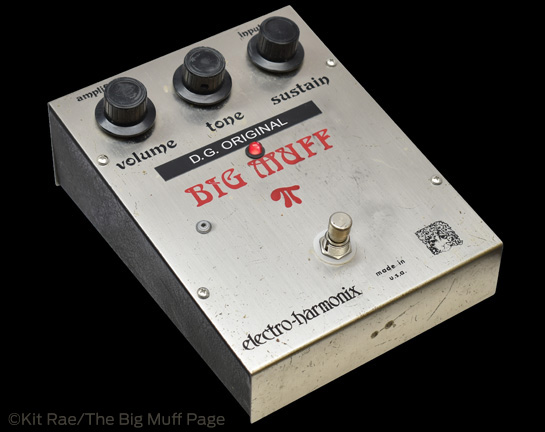
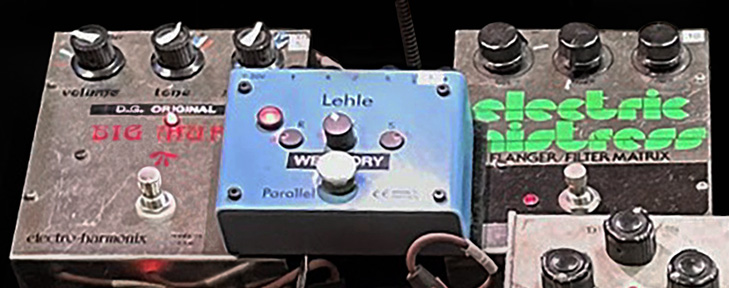
David's forty-one year old 1974 Ram's Head Big Muff and an original green Electric Mistress flanger, connected to a Lehle parallel mixer.
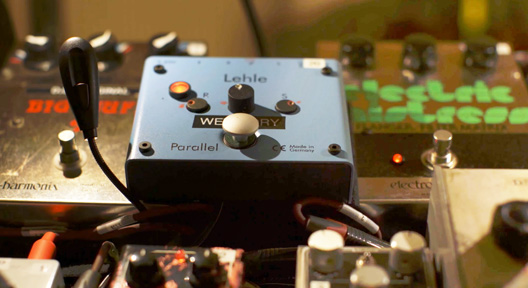
The Lehle parallel mixer was connected to the Electric Mistress to blend in 70% of the flange effect with the dry sound
The Big Muff was David's 1974 "DG Original" Ram's Head Big Muff. A few changes were made to this forty-one year old pedal before the tour. It now included
a red LED and a silver foot switch. Previously it had a black foot switch, which was a Pete Cornish replacement dating back to 1976. Pete also replaced the pots, added the Fuzz Face knobs, and an internal buffer in 1976. An Electric Mistress flanger pedal also made its way into the rig, something not seen on a Gilmour live pedlaboard since 1980-81 for The Wall concerts. There was a rack mounted Electric Mistress in David's 1994 tour rig, but the tour signal chains show it was not used. It was definitely used for the 2015 tour, and now sported a red LED and internal buffer added by Pete Cornish. A Lehle parallel mixer was connected to the Electric Mistress to blend in 70% of the flange effect with the dry sound.
(left) Pedals from the Rattle That Lock tour rehearsals. (right) Gilmour's custom Effectrode PC-2A compressor showing his tour settings.
The internal attack and knee trim pots have been moved to the top of the pedal. Effectrode offered this as a custom option.
For compressors, David used a Demeter Compulator, the same type he used for his 2006 live rig. Two new compressors were added to the rig, an Effectrode PC-2A compressor, and an Origin Effects Slide Rig Compact Deluxe compressor. The Effectrode was a photo optical valve comp that had internal attack and knee trim pots. David had his customized to move those controls to the top of the pedal. Effectrode offered this as a custom option at the time. The Slide Rig was a dual compressor, using two Cali76 compressor circuits cascaded in series. The Cali76 was based on the famous Urei 1176 studio compressor.
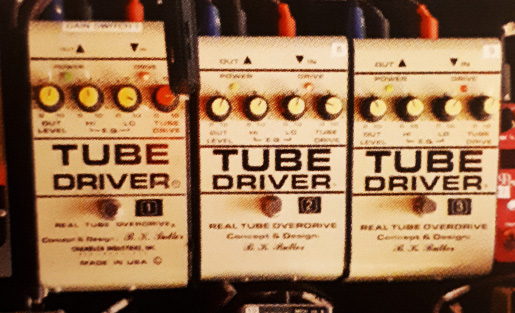
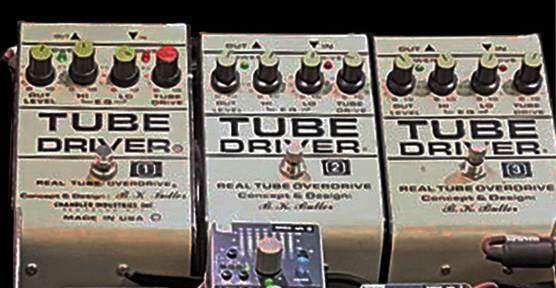

Gilmour's three Tube Drivers from the September Royal Albert Hall performances in 2016. Note the custom power supply jacks on the back.
Each of these Tube Drivers has been modified to remove the internal power transformer in order to reduce hum noise from proximity to the circuit.
David used three Tube Drivers in this rig, each set for a specific amount of drive for use on specific songs. Tube Driver #1 was an old BK Butler/Chandler model from the 1980s. There is a "GAIN SWITCH!" label is visible on the top end of the pedal, and what appears to be a switch on the back. It is not clear what this modification is, but based on the high drive knob position, and the very light drive produced by the pedal, it was a mod to give the drive pot a wider sweep before breaking into overdrive. Tube Drivers #2 and #3 were later model BK Butler 911 Tube Drivers. One was set for medium drive and one was set for heavy overdrive. All three were modified to remove the internal power transformers to reduce noise. Power jacks were added on the back to supply external power.
Gilmour's Boss GE-7 Equalizer settings for the tour
For equalization, David used his trusty Boss GE-7 equalizers, as were used on Pink Floyd's 1987-1989 and 1994 tours. These were modified by Pete Cornish for a flatter signal response at the zero slider setting. These were used to EQ parts of specific songs.
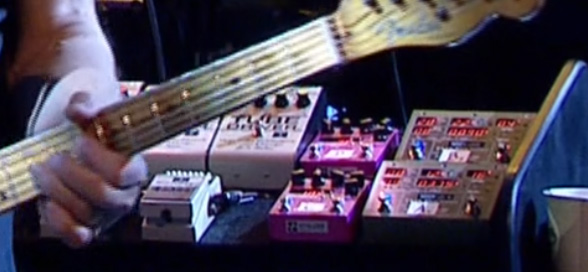
Gilmour's Providence Chrono delays and Free The Tone Flight Time delays
David used five delays for this tour. His main delays were two Free The Tone Flight Time delays, along with two Providence Chrono delays. His old MXR rack delay was also in the rig, but only used for a few songs. The Flight Times were labeled Ach4 and Bch5 on the switchboard and pedals. The "ch" meant midi channel 4 and 5. The Chronos were labeled C and D on the switchboard and pedals.
There were only two rack mounted effects. David used the same custom rack mounted Uni-vibe as used on the 1994 Pink Floyd tour and his 2006 tour. He also used the same MXR Digital delay System II from previous tours, but it broke down before the tour was completed.
David again used his modified Ernie Ball VP JR volume pedal, modified by Pete Cornish with 10k pot and fitted with a single in/out jack.
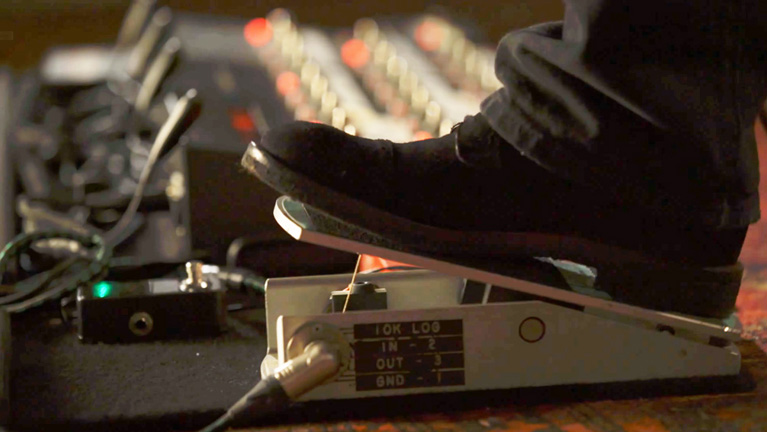
David's modified Ernie Ball VP JR volume pedal
Rehearsal pedals - Note the Seymour Duncan Twin Tube Blue and Hall and Collins Signature Echo that David is testing, which were not used on the tour
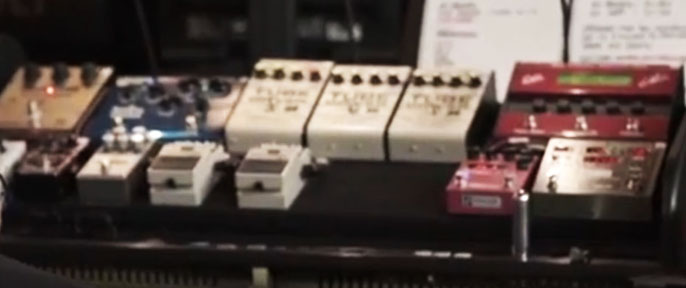
Rehearsal pedals - David included his original 1974 Big Muff on his pedalboard (upper left), the same one used for
Pink Floyd's 1977 Animals tour and the 1987-1988 Momentary Lapse of Reason tour. Pete Cornish had previously
modified this Big Muff by adding a buffer and replaced the old pots with higher quality pots.
Above is David's original Ram's Head Big Muff. The Boss FA-1 beside it was used to EQ and fix the volume
drop of the Electric Mistress flanger in rehearsals, but it was replaced with a Lehle parallel mixer for the tour.
The final version of David's pedalboard used in the beginning of the Rattle That Lock tour in 2015
Pedalboard Effects:
Left Side, Top Row - Ram's Head Big Muff, Lehle Mixer / Electric Mistress, Tube Driver #1 (BKB/Chandler), Tube Driver #2 (911), Tube Driver #3 (911), Providence Chrono Delay D , Flight Time Delay B
Left Side, Bottom Row - Effectrode Compressor, Demeter Compulator, Origin Effects Slide Rig, Boss GE-7 #1, #2, #3, Providence Chrono Delay C, Flight Time Delay A
RACK EFFECTS - LEFT SIDE
SKrydstrup MR10 Loop System (loops 1-10)
1. Effectrode Compressor
2. Demeter Compulator
3. Origin Effects Slide Rig Compact Deluxe
4. Whammy (in send/return of Skrydstrup Amp Splitter/Interface)
5. Ram's Head Big Muff
6. Tube Driver #1 (BKB/Chandler)
7. Tube Driver #2 (911)
8. Tube Driver #3 (911)
9. Lehle Mixer / Electric Mistress (both in same loop)
10. Boss GE-7 #1
MXR Digital Delay System II
Custom Uni-Vibe rack unit
Peterson 490 AutoStrobe tuner
RACK EFFECTS - RIGHT SIDE
SKrydstrup MR10 Loop System (loops 11-20)
11. Boss GE-7 #2
12. Boss GE-7 #3
13. Univibe (in rack)
14. Volume Pedal (in send/return of Skrydstrup Amp Splitter/Interface)
15. Providence Chrono Delay D (Guardian photo show last 2 digits as 10ms, probably 310 )
16. Providence Chrono Delay C (Guardian photo shows 0110ms)
17. Flight Time Delay B ch.5 (Guardian photo shows 0430ms)
18. Flight Time Delay A ch.4 (Guardian photo shows first 2 digits as 03, probably 380)
19. MXR Delay
20. Not Used
Skrydstrup Tuner Splitter - for Peterson tuner in left side of rack
Skrydstrup SC-1 Interface - Connects the MR10 rack units to David's SC-1 foot switcher,
and a slave foot switcher back stage with Phil Taylor
Skrydstrup Amp Splitter / Interface - Outputs to amps:
#1 - spare Alessandro to WEM cab #1
#2 - main Alessandro to WEM cab #2
#3 - main Hiwatt to WEM cab #3
#4 - spare Hiwatt to WEM cab #4
Skrydstrup SC-1 programmable midi switching system from the rehearsals, with XT module extension on the right side.
The labels below the effects loops switches are an early version of the effects, not the final tour version.
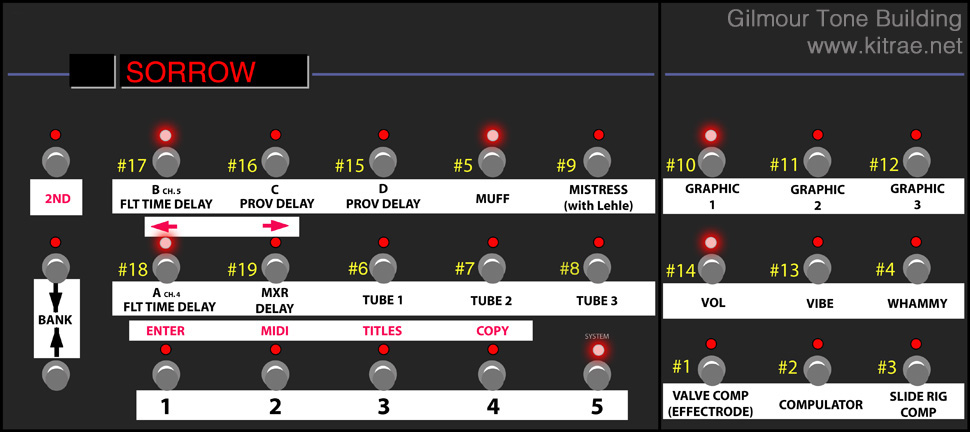
A diagram of Gilmour's SC-1 foot switcher from the South American leg of the 2015 tour
Gilmour's modified Ernie Ball VP Jr Volume Pedal, Digitech Whammy WH-1, and Skrydstrup SC1 programmable switching system
Gilmour's rack effects from the South American leg of the tour in 2015

front and back of Skrydstrup MR10 Loop System
front side of Custom Skrydstrup Tuner Splitter, SC1 Interface, and Amp Splitter / Interface
Back side of Custom Skrydstrup Tuner Splitter, SC1 Interface, and Amp Splitter / Interface.
The amp splitter had send/return connections for David's Volume Pedal and Whammy pedal, plus a spare send/return
AMPLIFIERS - Like David's 2006 tour, he blended his Hiwatt and Alessandro amps together. He used a 1974 Hiwatt DR504 Custom 50 and an Alessandro Redbone special, both running into WEM 4x12 speaker cabs. These were housed in a custom amp cabinet, along with a spare of each amp. One of those Alessandros has often been mis identified as a Bluetick Coonhound 20w amp, but in 2016 George Alessandro saw them back stage in NYC and confirmed both were his Redbone Specials.
The dark wood Redbone Special with the two eye knots on the front is the same one David used for his 2006 tour. Both RBS amps were custom voiced for David. George told me his standard RBS amp had a little too much preamp gain for David. He wanted it slightly cleaner, so a 6SN7 tube was used in the phase inverter. It is still a clean amp, but the lower gain does not start to distort utill farther up on the volume control, so David could have it louder and still be clean. He set the volume around 9:00 for the tour. The RBS sound has been described as having cleans like a 50w plexi Marshall mixed with a compressed Fender tweed amp, with Marshall plexi-like overdrive at high volume.
AMPS
#1 - Blonde Alessandro Redbone Special 55W - main.
#2 - Brown Alessandro Redbone Special - spare.
NOTE - this seems to have been mistaken for a Bluetick Coonhound 20W in the past, but it is actually a Redbone Special.
#3 - 1974 Hiwatt DR504 - main
#4 - 1974 Hiwatt DR504 - spare
Gilmour's 1974 Hiwatt DR504 Custom 50 was his main amplifier. The one below it was a spare.
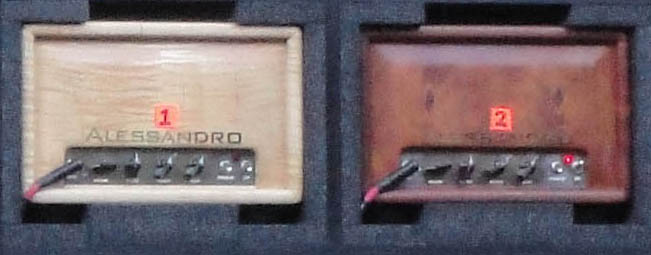
Gilmour's Blonde and brown Alessandro Redbone Special 55W amplifiers. One was used as a spare
Gilmour's Alessandro Redbone Special 55W settings
SPEAKERS AND CABINETS - As with the his 2006 tour, David used his trademark WEM 4x12 Super Starfinder 200 speaker cabinets, one for each amplifier. A third was used as a monitor to hear David's backup guitarist. The WEM powered by the Hiwatt was housed with David's standard Fane Crescendo speakers. It is unknown what speakers were in the WEM powered by the Alessandro amp, but those were likely Celestions.
SPEAKER CABS - 3 WEM speaker cabs behind David
Right WEM with Fane Crescendo speakers labeled #3 for main DR504
Middle WEM (possibly filled with Celestions) labeled #2 for Alessandro Redbone Special
Left WEM labeled #1 - spare used to monitor David's backing guitarist
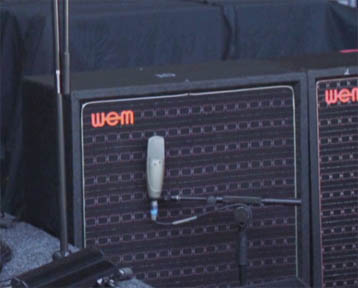
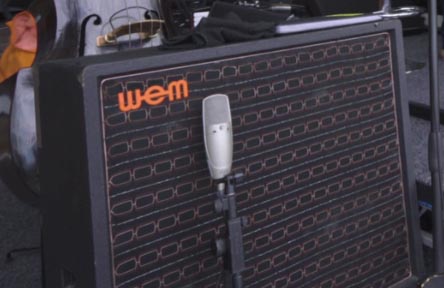
David's spare WEM 4x12 speaker cabinet (left) and one used by his backing guitarist (right)
GUITARS - As on the 2006 tour, David's main guitar was his Black Strat, a modified 1969 Fender Stratocaster with a 1983 maple neck, Seymour Duncan SSL-5 bridge pickup, and shortened tremolo arm. It also had a switch that allowed the neck pickup to be added to any other pickup position, although David rarely, if ever, used it for recording, and he did not use the switch on this tour.
This was the last tour David used the Black Strat to perform live. It was auctioned for charity in 2019, but David owns several Fender Black Strat replicas.
David playing his modified 1969 Black Fender Stratocaster. This was the last tour it was used for before being auctioned for charity in 2019
David used his 1956 Gibson Les Paul gold top with P-90 pickups for 5AM and Girl in the Yellow Dress. It is the same guitar he used for his 2006 tour, and used for the 2007 Barn Jams and Island Jam. David had a similar 1955 Les Paul goldtop that he used on The Wall, but his desire for one with an original factory installed Bigsby tremolo, not an after market one, led to this purchase. It appears to have become his main Les Paul, as he sold the 1955 LP at auction in 2019.
David playing his 1956 Gibson Les Paul goldtop with Bigsby tremolo and P-90 pickups
David played his old "Workmate"Fender on this tour, which was essentially an Esquire with a neck pickup added. He used it on Rattle That Lock, Today, Fat Old Sun, and Run Like Hell. The last time David used this guitar on tour was for The Wall in 1980-81. It is the same guitar David wrote Run Like Hell on, and appears on the back cover of his second solo album, About Face.
David playing his "Workmate" guitar, supposedly a Fender Esquire with heavy body damage and a neck pickup installed
For slide guitars David used his red Jedson lap steel tuned to Open Em (EBEGBE) and a blonde Fender Deluxe lap steel tuned to Open G (DGDGBE).
The Jedson, a clone of the Fender Deluxe lap steel, was purchased in the 1970s and used on Pink Floyd tours. It was used for One of These Days on this tour. In the late 1980s it was modified with an EMG-H pickup (confirmed in the Their Mortal Remains book), an SPC control (presumed), and two switches. The EMG-H was a single coil pickup in humbucker sized housing, similar to the EMG-SA, but with a ceramic magnet instead of alnico. The difference is slightly less midrange than the SA model. I am not sure what the two switches control, but the one labeled MID possibly switches the SPC control in and out of the circuit and the other possibly switches the battery out of the circuit to prevent it from being drained when not in use. The Jedson had also been modified to add a Roland Hex synthesizer pickup, installed behind the EMG pickup. A large cavity was routed out to the right if the output jack to house the electronics for the Hex pickup, so the two switches may have originated as controls for it and are now inactive. The Hex was removed prior to the 1987 tour, leaving an empty cavity.
In the past, the Jedson was modified to add a Roland Hex synthesizer pickup, installed behind the EMG pickup. A large cavity was routed out to the right if the output jack to house the electronics for the Hex pickup. It was removed prior to the 1987 tour and the cavity was filled and painted over prior to David's 2006 On an Island tour.
The Fender Deluxe lap steel is the same one David has used since the 1994 Division Bell tour, and one his 2006 On An Island tour. It appears to have stock Fender pickups. He used it for Great Gig in the Sky, High Hopes, and A Boat Lies Waiting.
David playing his red Jedson lap steel with EMG-H pickup, tuned to Open Em (EBEGBE)
David playing his Fender Deluxe lap steel tuned to Open G (DGDGBE)
For acoustics David's main guitar was a 1958 Gibson Country Western model acoustic guitar with an L. R. Baggs pickup, the same one used for his 2006 tour. He used it for Wish You Were Here and Fat Old Sun. It was auctioned for charity in 2019. David use a Taylor NS24 nylon string acoustic guitar for the classical guitar sound on High Hopes. Only 34 of this model were produced (thanks to George for the info). The NS24 was Taylor's first non-cutaway nylon-string Grand Auditorium guitar.
There is a pickup that you can actually put onto these guitars which is more like an electric guitar pickup and it has a very, very nice sound to it. It meant that on the more recent tours for On An Island and Rattle That Lock, I was able to use the Country Western, ie. Use an old guitar but with a modern pickup on it. It meant that you could revert to using a beautiful old guitar on stage because of that particular L. R. Baggs pickup - David Gilmour Christies Auction
David playing his Taylor nylon string acoustic guitar
David playing his 1958 Gibson Country Western acoustic guitar
Kit’s Secret Guitar, Gear, and Music Page
Guitar stuff, gear stuff, soundclips, videos, Gilmour/Pink Floyd stuff, photos and other goodies.
Copyright Kit Rae.
VISIT MY SWORDS, KNIVES and FANTASY ART WEBSITE www.kitrae.net

